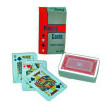Using playing cards is a great tool for working on bilateral skills as well as hand-finger coordination and manipulation skills. They are versatile and adapted easily for almost every age child through adult. They can also go a long way, in a waiting room, on a rainy day, with or without a partner or during a treatment session. There are so many games and activities you can do with just one deck of cards. (Visit
www.pfot.com for mini cards, and Sets a different kind of card game)- Some simpler activities (especially for younger players): Sort them by: color, shape, number, shape and number. Memory or concentration with as few or as many pairs is appropriate for the specific players.
- Remember the game of “war”? Use it work on numbers or the concepts of more/less, bigger/smaller or before/after. You can flip over two cards or divide the deck and each have a stack and turn over 1 card each. Ask the child which card that is more than the other. In the classic game of “War” the player with the larger number gets the set. The player with the most cards wins.
- Variation of “war”: Players take turns revealing a card and putting them on their discard pile or other players discard pile. If your newly revealed card is the next number or the previous number to the card on your opponents pile, you may place your card on his pile and go again. Cards may be taken from your hand or the top card of your discard pile. Winner is first to be without any cards.
- Teach a simple solitaire game. (Visit the pocket full of therapy Blog for variations and directions)
- A fun variation of memory: Split your deck of cards into red and black. Spread out the black cards face down and deal the red ones evenly among players. Flip over one black card and see if you have the number match in your hand. The first person to match all their red cards is the winner. You will have two of each number so you have to pay attention because another player might beat you to the match. Match shapes if you need a simpler version.- Work on math skills: Separate the cards, so you only have one set of number cards and your child has a second set. Have your child put them in order. Now place two cards on the table and ask your child to add them together, place the answer next to your two cards. You can do the same with subtraction and multiplication. It may be helpful to have a +, -, x and an = written on cards to place next to the numbers. If this is too difficult, you may want to place a card face up on the table and have your childcount out the matching number of small objects (coins, buttons, blocks, or pom poms). - Use in gross motor activities: Number cards are face value, jacks equal 11, queens equal 12, kings equal 13, and aces equal 15. Pull a card and that equals the number of push ups your child has to do. Have them write the number on a piece of paper or write and wipe board so they can keep track. You can use this for sit ups, jumping jacks, squats, or whatever you may be working on. You can even incorporate the cards into an obstacle course. Pick a card, jump that many times, pick another card and balance for that many seconds, pick a third card and throw the ball at a target that many times.










